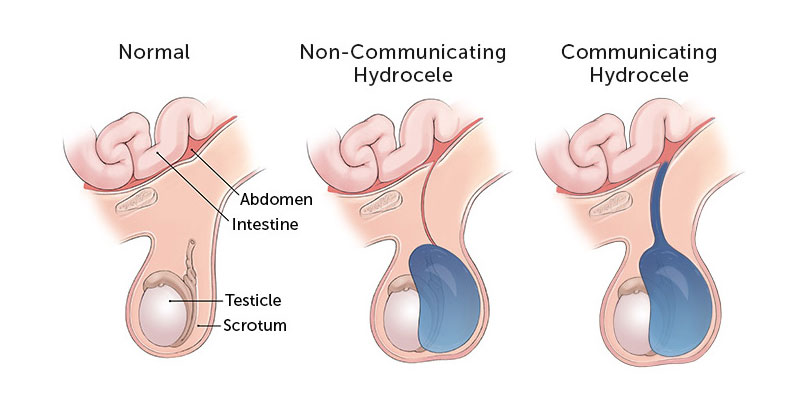A hydrocele (Hi-droe-seel) is a type of swelling in the scrotum that occurs when fluid collects in the thin sheath surrounding a testicle. Hydrocele is common in newborns and usually disappears without treatment by age Older boys and adult men can develop a hydrocele due to inflammation or injury within the scrotum.
A hydrocele usually isn't painful or harmful and might not need any treatment. But if you have scrotal swelling, see your doctor to rule out other causes.
Usually, the only indication of a hydrocele is a painless swelling of one or both testicles.
Adult men with a hydrocele might experience discomfort from the heaviness of a swollen scrotum. Pain generally increases with the size of the inflammation. Sometimes, the swollen area might be smaller in the morning and larger later in the day.

Baby boys : A hydrocele can develop before birth. Normally, the testicles descend from the developing baby's abdominal cavity into the scrotum. A sac accompanies each testicle, allowing fluid to surround the testicles. Usually, each sac closes and the fluid is absorbed.
Sometimes, the fluid remains after the sac closes (noncommunicating hydrocele). The fluid is usually absorbed gradually within the first year of life. But occasionally, the sac remains open (communicating hydrocele). The sac can change size or if the scrotal sac is compressed, fluid can flow back into the abdomen. Communicating hydroceles are often associated with inguinal hernia.
Older males : A hydrocele can develop as a result of injury or inflammation within the scrotum. Inflammation might be caused by an infection in the testicle or in the small, coiled tube at the back of each testicle (epididymitis).
Most hydroceles are present at birth. At least 5 percent of newborn boys have a hydrocele. Babies who are born prematurely have a higher risk of having a hydrocele.
Risk factors for developing a hydrocele later in life include:
A hydrocele typically isn't dangerous and usually doesn't affect fertility. But a hydrocele might be associated with an underlying testicular condition that can cause serious complications, including: Infection or tumor. Either might reduce sperm production or function. Inguinal hernia. The loop of intestine trapped in the abdominal wall can lead to life-threatening complications.
In baby boys, a hydrocele sometimes disappears on its own. But for males of any age, it's important for a doctor to evaluate a hydrocele because it can be associated with an underlying testicular condition.
A hydrocele that doesn't disappear on its own might need to be surgically removed, typically as an outpatient procedure. The surgery to remove a hydrocele (hydrocelectomy) can be done under general or regional anesthesia. An incision is made in the scrotum or lower abdomen to remove the hydrocele. If a hydrocele is found during surgery to repair an inguinal hernia, the surgeon might remove the hydrocele even if it's causing no discomfort.
